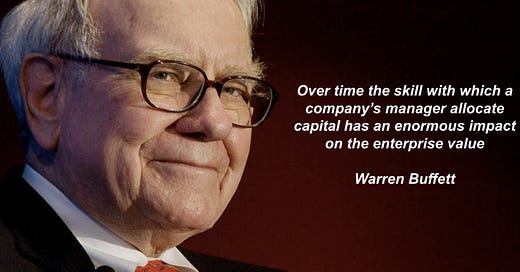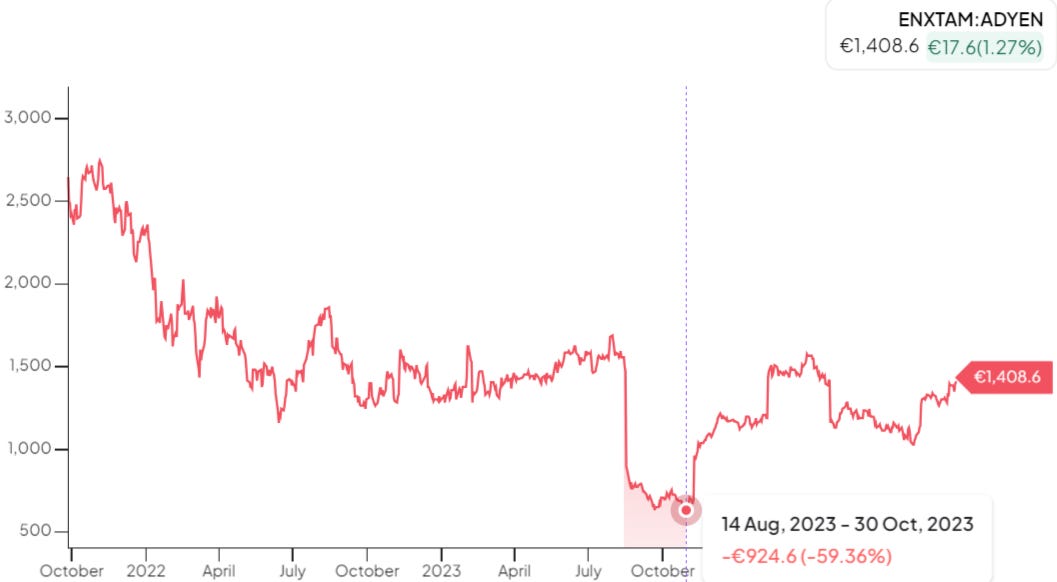We’ve all heard the famous Charlie Munger quote “Show me the incentive and I'll show you the outcome”. This quote has stuck with me through my investment journey and in general life.
In this brief article I will highlight the importance of incentives and why they can be a huge factor for shareholder returns.
When we analyse businesses, some quantitative metrics are used more than others, such as P/E, P/B, P/FCF, EV/EBIT all come to mind. We also go through the income statement, balance sheet and cash flow statement. Depending on our investment style, might focus more on dividends or for quality ROIC. One qualitative topic I personally believe is of great importance that criminally gets overlooked is managements “skin in the game” and managements skill at capital allocation.
Importance of management
We choose to invest in a specific business for a claim of the company’s cash flows from now into the future. The main job of a CEO is to allocate this cash to get the best possible returns for shareholders. Unfortunately for us, not many CEOs have these capital allocation skills. Here’s an excerpt from Capital Returns.
“Capital allocation isn’t a common skill among CEO’s. This comes as no surprise as most have risen to the top because they have excelled in areas such as marketing, production and engineering”
It is very rare to find another Warren Buffett who’s a master at capital allocation. However, there are tell tale signs we can use that can be good indicators to identify prime stewards of capital. This exercise would require looking at past capital allocation decisions to determine if cash was spent wisely.
Management have 5 ways they can deploy cash.
Pay dividends,
Share buybacks,
Acquisitions,
Pay down debt.
Reinvest for organic growth
Two of these allocation decisions are most likely due to the business being in a later stage in its life cycle such as paying down debt, (common among mature companies as they taken on debt and changed their capital structure as they mature) and dividends. Businesses that pay dividends to its shareholders are likely they have passed their high growth phase and can’t redeploy huge amounts of cash at high rates of return.
To judge managements allocation decisions we have to look into the past. Acquisitions, stock repurchases and their organic reinvestment opportunities. Looking into the past we can determine if management used the company’s cash unwisely by overpaying for acquisitions “either through equity, cash or both” or repurchasing shares at market highs, both common practices when interest rates are low and both value destroying.
We need to look for management that allocate capital in a counter cyclical manner, as you can already guess this would mean repurchasing shares during market lows or when management believe the stock is undervalued and acquiring businesses that are under distress during market downturns.
Unfortunately for us, not many CEO’s act in this manner and generally behave very similar to their peers. One standout CEO is Peter van der Does who acted in a counter cyclical manner when Adyen started to ramp up their hiring process when all of their peers where downsizing. This “against the crowd” decision resulted in Adyen acquiring top talent and reasonable salaries as there was not much competition for their services at the time. This playbook from van der Does was all about investing for the next growth phase for Adyen regardless of their short term profitability, another positive short term pain for long term gain scenario in my opinion.
As you can guess, the market didn’t initially reward Adyen during this growth phase (Below) as many investors and fund managers are too pre-occupied by the most recent earnings and the next 12 months profitability. For long-term orientated management and investors these opportunities can be blessing.
A book I would highly recommend The Outsiders . This book covers eight CEO’s who excelled at capital allocation and their unconventional approach to corporate management.
Skin in the game
Insider ownership is a way to determine if management have the same long-term interests as shareholders. Both benefit if the business thrives. High insider ownership is common with founder led businesses and also businesses that are family owned and have been passed down through generations. Executives can also build up large positions from open market purchases “My preference” or through incentives they’ve been awarded from performance based targets.
Now the saying “skin in the game” can mean two things, either management have significant insider ownership or incentives through performance awards that vest over multiple years. The performance targets for these incentives should be tied to the company's strategic goals. Common performance metrics include,
Revenue growth
Eps growth
Free cash flow per share growth
Return on invested capital
Total shareholder return
There’s a wide range of performance metrics and can differ from company to company. As a long term shareholder, I tend to look for metrics that are long term focused that can’t be exploited. What I mean by this is that some metrics can be achieved by large acquisitions (Revenue growth and EPS growth come to mind) also return on equity can be manipulated by the addition of debt, both highly probable to destroy value for shareholders. I believe managements intentions aren’t to destroy shareholder value but their decisions are likely to be influenced by their incentives. Return on invested capital or ROIC is a favourite performance metric of mine due to its solidity. If management overpays for acquisitions (increases goodwill), takes on additional debt or invests in poor return projects will all lower ROIC. This performance metric can safeguard investors from careless executive decisions.
High ownership stakes from management and long term incentives that vest over multiple years are probably the best way of concentrating the minds of management on the true value drivers and should shield against excessive risk taking.
Here’s another Charlie Munger quote on the power of incentives. This example highlights that incentives can filter through the whole organisation and are not limited to management.
“From all business, my favourite case on incentives is Federal Express. The heart and soul of their system – which creates the integrity of the product – is having all their airplane come to one place in the middle of the night and shift all the packages from plane to plane. If there are delays, the whole operation can’t deliver a product full of integrity to Federal Express customers. And it was always screwed up. They could never get it done on time. They tried everything – moral suasion, threats, you name it. And nothing worked. Finally, somebody got the idea to pay all these people not so much an hour, but so much a shift and when it’s all done, they can all go home. Well, their problems cleared up overnight.” Charlie Munger.
Conclusion
Analysing management is a crucial topic and should be high on your priority list when when deciding to invest in a business. Like I mentioned in the start of the article, we invest into a business for a claim of its cash flows. We need to believe we are putting our money with long term orientated management, that possess integrity and are great capital allocators with the skill to compound our investments far out into the future. Not too much to ask it it? Some that come to mind are Warren Buffett, Jeff Bezos, Jack Welch, Mark Leonard and Peter van der Does.
Its a tough task to identify these rare exceptional managers and we have to accept that sometimes our judgement will be incorrect. Putting aside the past capital allocation decisions made, everything else is subjective. We all have our own opinions. The best we can do it try to eliminate the obvious candidates that don’t fit into ones management criteria.
This article wouldn’t be complete without a picture of the GOAT !!
Thank you for reading.
DInvests
Disclaimer: I have a beneficial long position in the shares of $ADYEN. I can’t guarantee the accuracy of the information provided in the newsletter. All statements express personal opinions and information gathered online. Any estimates, forward looking statements and assumptions made in this newsletter are unreliable. Any information in this newsletter is for educational and entertainment use only and should not be taken as investment advice.






